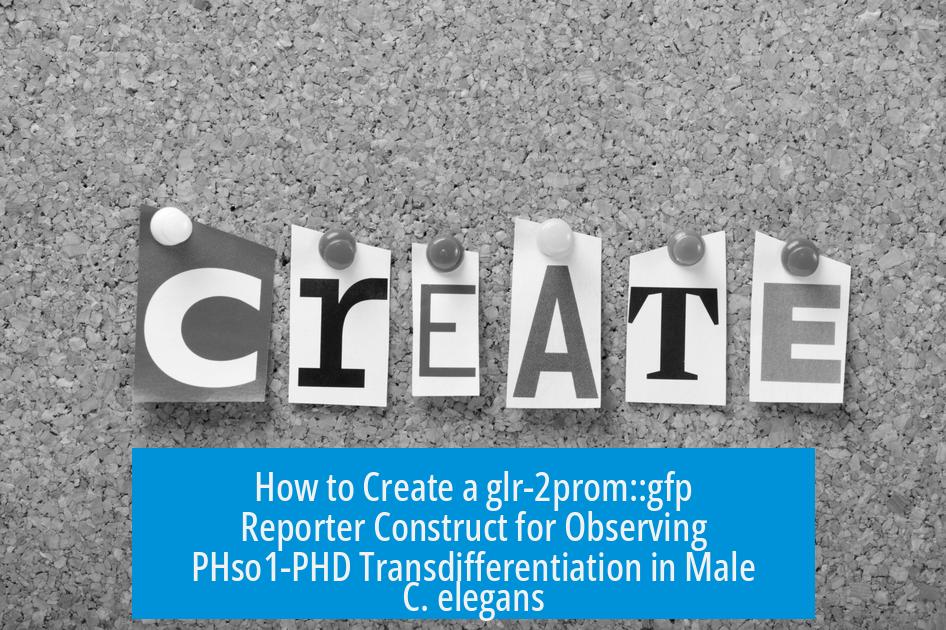How to Make a glr-2prom::gfp Reporter Construct for Visualizing PHso1-to-PHD Transdifferentiation in Male C. elegans
The glr-2prom::gfp reporter construct serves to visualize the transdifferentiation of PHso1 cells into PHD neurons in male C. elegans by driving GFP expression under the control of the glr-2 promoter. This method involves isolating genomic DNA, cloning the glr-2 promoter, and inserting it into a GFP expression vector compatible with C. elegans.
1. Isolate Genomic DNA
Begin by extracting high-quality genomic DNA from C. elegans. This DNA provides the template for amplifying the glr-2 promoter region. Use standard protocols ensuring purity and integrity suitable for PCR amplification.
2. Clone the glr-2 Promoter
- Identify and amplify the promoter region of glr-2, approximately 1-2 kb upstream of the gene’s start codon.
- Design PCR primers that flank this promoter and include restriction enzyme recognition sites compatible with your chosen cloning vector.
- Use a high-fidelity DNA polymerase to amplify the promoter segment to maintain sequence fidelity.
3. Construct the glr-2prom::gfp Reporter
- Select a GFP expression vector validated for use in C. elegans. This ensures proper GFP expression and reliable visualization.
- Digest both the amplified glr-2 promoter and vector with the same restriction enzymes corresponding to the primer-flanked sites.
- Ligate the glr-2 promoter into the vector, replacing the original promoter. Confirm that the insertion places the GFP coding sequence in the correct reading frame relative to the promoter.
- Verify the promoter length is sufficient for faithful expression by confirming the size of the inserted promoter sequence, considering that too short a promoter may not drive expression effectively.
Additional Considerations
- Sequence the cloned region to verify correct insertion and to exclude mutations.
- Test the reporter construct in male C. elegans to confirm GFP expression in the PHso1-to-PHD transitioning cells.
Summary of Key Steps
- Extract genomic DNA from C. elegans.
- Amplify ~1-2 kb glr-2 promoter using primers with flanking restriction sites.
- Replace vector promoter with amplified glr-2 promoter ensuring proper reading frame.
- Use a C. elegans-compatible GFP vector to ensure effective expression.
- Verify promoter length is sufficient for proper GFP expression.
How do I isolate the glr-2 promoter region for cloning?
Isolate genomic DNA from C. elegans first. Use primers flanked with restriction sites to amplify about 1-2 kb upstream of the glr-2 gene. This region acts as the promoter for your construct.
What vector should I use for constructing the glr-2prom::gfp reporter?
Choose a vector compatible with C. elegans that expresses GFP. Replace its original promoter with the glr-2 promoter insert using matching restriction sites. The GFP must be in-frame with the promoter.
How can I ensure the GFP is properly expressed in the reporter construct?
Make sure the glr-2 promoter fragment is large enough, usually 1-2 kb upstream. Confirm proper frame alignment between the promoter and GFP sequence to allow correct expression in C. elegans cells.
Why are flanking restriction sites important in primer design?
They allow you to digest and ligate the amplified glr-2 promoter into the vector at specific sites. This facilitates replacing the vector’s original promoter with glr-2 without disrupting the GFP coding sequence.
What is critical when replacing the vector’s promoter with glr-2 promoter?
You must maintain the reading frame between the promoter and GFP. Use the same restriction sites for cloning to ensure correct orientation and expression of GFP driven by the glr-2 promoter in male C. elegans.





Leave a Comment